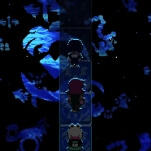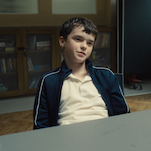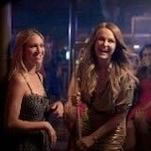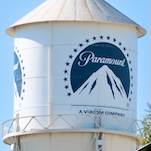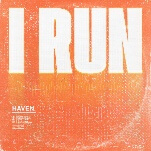Day Seven, our last at TIFF, brings horror from Rob Zombie and Barry Levinson and a second take on To The Wonder

The Lords Of Salem
Director/Country/Time: Rob Zombie/USA/101 min.
Cast: Sheri Moon Zombie, Bruce Davison, Dee Wallace
Program: Midnight Madness
Headline: Get Behind Me Satan
Scott’s Take: As spotty as his track record has been to this point—one spectacular sequence in the otherwise middling House Of 1,000 Corpses, twoHalloween movies of some distinction but questionable necessity, and only a single sleazoid horror gem in The Devil’s Rejects—director Rob Zombie is one of our few true horror auteurs, someone with a distinct sensibility who works persistently in the genre. That sensibility, steeped in ‘70s horror texture and astonishingly detailed production design, is on full display in The Lords Of Salem, a silly piece of witchy hokum that’s redeemed by the Zombie touch. It opens in 1692 Salem, where a coven of Satan-worshipping witches are executed—with cause!—by a religious persecutor. Cut to the present day (which is pretty much 1972 with Internet connectivity), where Salem DJ Sheri Moon Zombie receives a mysterious record in a wooden box by a band calling itself The Lords. After playing the record, its mesmeric powers unleash all manner of Satanic hallucination that link back to those events in Salem 300 years earlier. With nods to The Shining, The Exorcist, The Fog, Rosemary’s Baby, and early Dario Argento—and the casting of character actors like Dee Wallace, Meg Foster, Maria Conchita Alonso, and others—Zombie has constructed a cinematic time machine akin to Ti West’s The House Of The Devil, only more gorgeously baroque and with all the devil worship upfront. On the latter point, it’s less frightening than gorily ritualistic/fetishistic and it ends inconclusively and unsatisfactorily. But Zombie auteurists will find much to cherish, including a use of Velvet Underground songs that’s nearly worthy of “Freebird” in The Devil’s Rejects.
Grade: B
The Bay
Director/Country/Time: Barry Levinson, USA, 84 min.
Cast: Will Rogers, Kristen Connolly, Kether Donohue
Program: Midnight Madness
Headline: Just when you thought it was safe, whatnot
Noel’s Take: The prospect of Oscar-winning writer-director Barry Levinson making a found-footage eco-horror film is a smidgen dismaying, as though he couldn’t get a better gig at this stage of his career. But maybe it takes an old pro like Levinson to show how an increasingly played-out genre can be improved. As a horror film, Levinson’s The Bay (written by Michael Wallach) is just okay. Set on July 4th in a sleepy waterfront Baltimore town, the movie follows the rapid progression of a mysterious flesh-eating ailment that affects residents who’ve been in contact with the local water supply; but only occasionally does Levinson deliver good, jolting scares. Instead, he focuses on constructing a full-scale narrative, using these new, caught-on-the-fly techniques—re-imagining Jaws for the YouTube/Skype/nannycam era. There’s a surprisingly large cast of characters in The Bay, who each get their stories told via snippets of footage that are woven together into a good approximation of a ‘70s-style disaster movie. Ultimately, the kind of movie The Bay is (both in content and approach) is too familiar, no matter how impressively realized. But without laying on too heavy a hand, Levinson does have strong points to make with The Bay, not just about the extremest outcome of environmental neglect—but also about how the past decade-plus of “starve the beast” anti-government policies have left us unprepared for the inevitable. That’s some real horror right there.
Grade: B+
Beyond The Hills
Director/Country/Time: Cristian Mungiu/Romania/155 min.
Cast: Cosmina Stratan, Cristina Flutur, Valeriu Andriuta
Program: Masters
Headline: Sister Act, Too
Scott’s Take: Cristian Mungiu’s follow-up the brilliant Palme D’Or-winning 4 Months, 3 Weeks And 2 Days draws a similar gnawing tension from two female friends who struggle under institutional dictates. But where 4 Months tracked two university seeking a black-market abortion in Nicolae Ceausescu era, Beyond The Hills takes place in an isolated Orthodox monastery where God’s law applies, even if it’s ultimately destructive. Cosmina Stratan and Cristina Flutur shared the Best Actress prize at Cannes for their fine turns as childhood friends (with benefits) from the orphanage who split up as young adults, with Flutur heading off to Germany for work and Stratan settling at the monastery—in part, it’s suggested, because she had nowhere else to go. The film opens with Flutur reuniting with Stratan, but when Stratan takes her friend back to the monastery, it’s clear that Flutur’s mental instability is going to become a problem. After failed attempts to get Flutur in line and some increasingly violent episodes, “Papa,” the monastery head, concludes that she has the devil inside her and takes drastic steps to exorcise the beast. With each new development, Mungiu ratchets up the tension, bit by bit, until Stratan and Flutur’s situation reaches white-knuckle territory almost imperceptibly. (The famous dinner scene in 4 Months, where our heroine is pinned helplessly within the frame, is done with a few minor variations here.) Mungiu strongly condemns the religious laws that fail Flutur so utterly, but not to the point where “Papa” and the nuns are cast as villains or sadists—they’ve simply walled themselves into a belief system that can’t adequately address Flutur’s volatile emotional state. It’s not only great drama, but a vivid window into another world.
Grade: A-
Come Out And Play
Director/Country/Time: Makinov, Mexico, 95 min.
Cast: Ebon Moss-Bachrach, Vinessa Shaw
Program: Midnight Madness
Headline: Caution, children at murder!
Noel’s Take: At the start of the moody horror movie Come Out And Play, an American tourist and his pregnant girlfriend rent a boat and motor out to a remote Mexican island noted for its beautiful beaches and wild carnival celebrations, but when they arrive, the resort seems empty, aside from some kids playing in the street. Then the kids pick up blunt objects and make the new visitors the target of what appears to be an ongoing adult-hunt. According to the credits, Come Out And Play was “made” (meaning written, shot, directed and edited) by the masked, anonymous Belarusian filmmaker “Makinov,” who based it on the 1976 Spanish film Who Can Kill A Child? The title of the original pretty well sums up what’s interesting about Come Out And Play. When the heroes finally do encounter a living grown-up, he admits that when the children went feral, the parents didn’t know what to do, because they couldn’t bring themselves to fight back against their progeny. Can this couple do any better, when these scruffy, smiling tots come at them bearing hammers and knives? But while Makinov brings an effectively gritty and atmospheric feel to Come Out And Play, he never solves the common “creepy mystery” problem of how to sustain suspense without over-explaining what’s happening. He pulls back way too much, such that the movie is 45 minutes of the Americans roaming the island, going, “Where is everybody?” followed by 45 minutes of them running for their lives (all capped off by five more minutes for an ironic twist ending). It’s very good in pieces; but on the whole, Come Out And Play feels like it’s missing a few necessary twists.
Grade: C+
The End Of Time
Director/Country/Time: Peter Mettler, Canada, 114 min.
Documentary
Program: Masters
Headline: It’s about time
Noel’s Take: Continuing the free-associative approach to non-fiction filmmaking that he explored in his 2002 epic Gambling, Gods And LSD, noted director/cinematographer Petter Mettler’s The End Of Time is an essay-film that combines interviews, images and narration in ways intended to get the audience to meditate on some general ideas and concepts. Specifically, Mettler is interested in how we perceive time. Traveling all over the world, from active volcanoes to an enormous particle accelerator, Mettler considers our relationship to what is, essentially, an abstract concept—and one that not everyone sees the same way. What is “a long time” versus “a blip,” relatively? How fast do we need to move to get out of the way of danger, or to stay ahead of the curve? How well can we perceive the changes all around us, some caused by the slow process of natural decay and some caused by man’s inability to leave well-enough alone? Mettler himself is in no hurry to raise these questions, and has no intention of resolving them. The End Of Time jumps slowly from subject to subject—spending a little time with a techno musician, for example, and then examining how the spread of the automobile in the 20th century made work and leisure life much faster—and asks the audience to make its own connections. The contemplative, free-ranging approach can be a little too elusive at times, but Mettler does succeed in creating a calming space, where the viewer can scrutinize aged wood, or people dancing, or ants tugging at a dead grasshopper, and think about how in some ways time zips by, and in other ways, it creeps.
Grade: B



